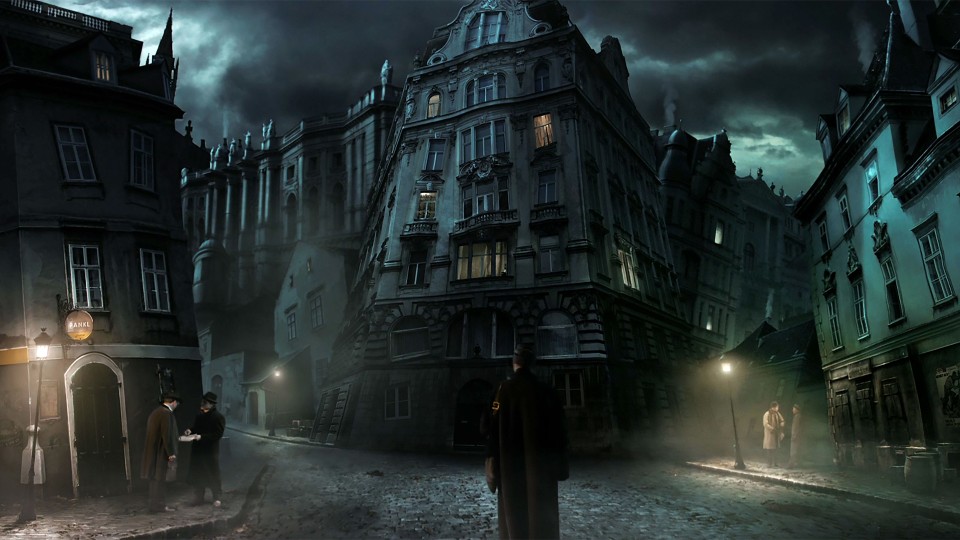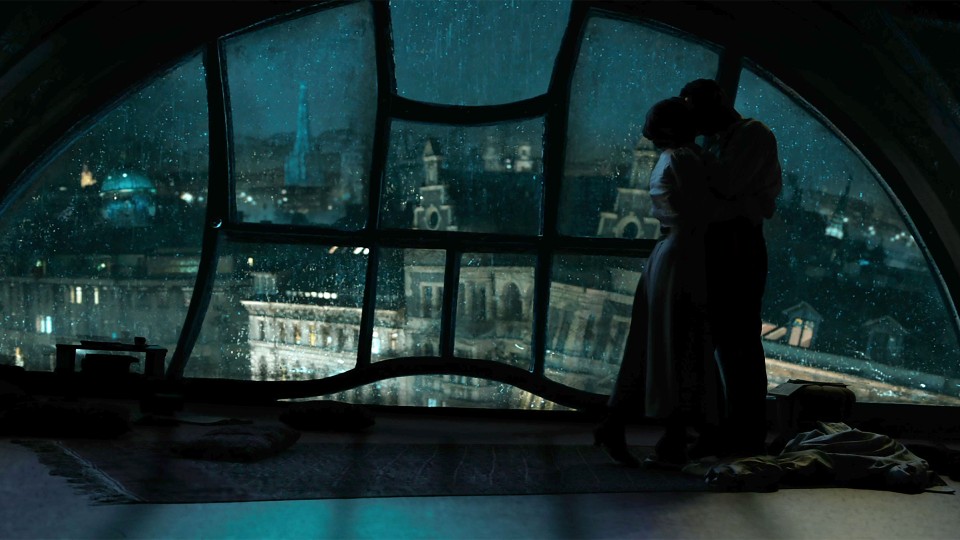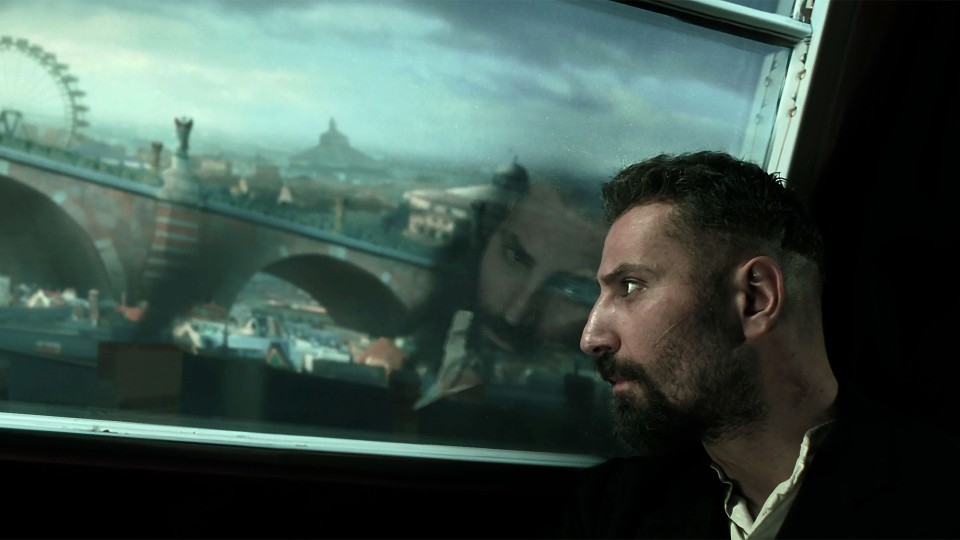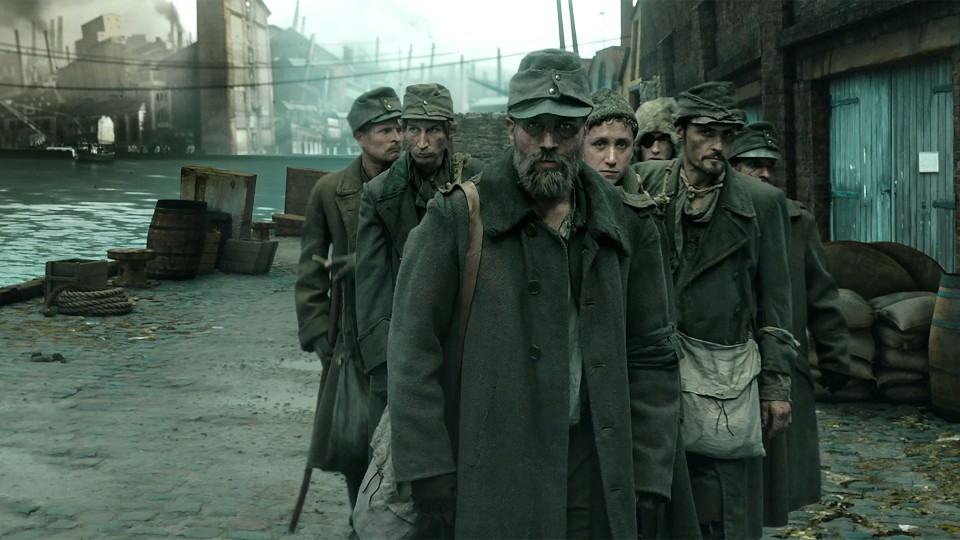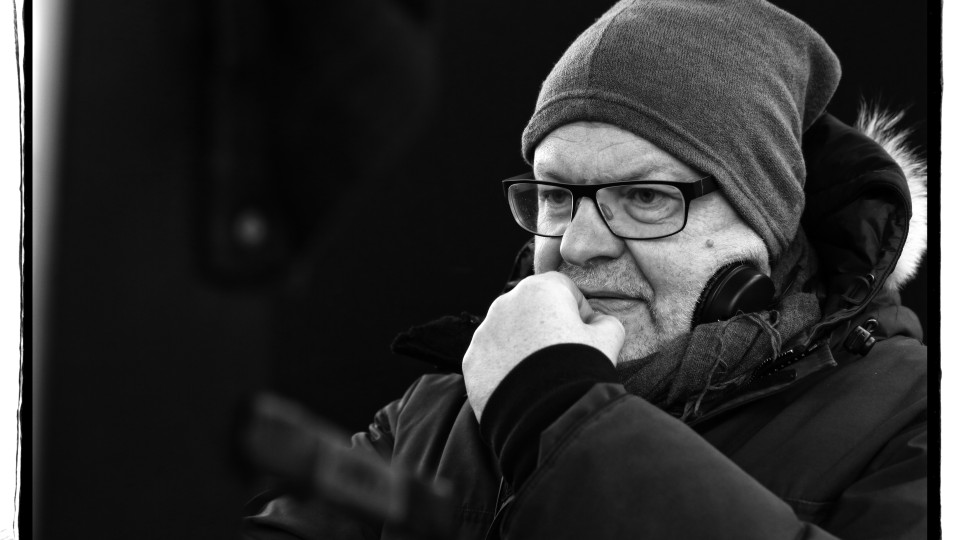Peter Perg’s world has become completely out of line. In 1914, when he left to fight in the First World War, full of optimism,
it was for his Emperor
But when he returns from prisoner of war camp several years after the war finishes with a handful
of his men, it is to discover that only a fraction of the former Austro-Hungarian Empire now calls itself Austria. Stefan
Ruzowitzky filmed his actors for HINTERLAND using blue screen technology. The dark lanes, the façades and structures of desolate Vienna which appears completely out
of line were all created on the computer, providing a grim background to the hunt for an obsessed serial killer.
For your new film HINTERLAND you have chosen an interesting era – the years after the end of the First World War – which throws
up questions seldom posed today: what happens when hostilities end but nobody knows which laws still apply and, even worse,
nothing is the way it used to be? What considerations prompted you to focus on this epoch?
STEFAN RUZOWITZKY: I was involved in a project several years ago that was set in this period, but ultimately nothing came of it. At the time
I read a great deal of literature from the early 1920s and the immediate post-war period, and it struck me that the cultural
shock after the First World War was much greater than after the Second World War, not only in Austria but throughout the whole
of Europe. After all, discussion of the Holocaust was taboo for a long time and only became the focus of attention much later.
After the First World War everything had been knocked off balance. People really had the feeling that something had come to
an end and something completely new was beginning, unlike during the tame 1950s, when there was a much greater attempt to
maintain the peace and quiet that had been established with such an effort.
HINTERLAND combines two elements which recur in your narratives: the confrontation with the historical period, and the genre
of a horror-thriller with the hunt for a serial killer. Three people are listed as scriptwriters: Hanno Pinter and Robert
Buchschwenter as well as you. How did the screenplay develop?
STEFAN RUZOWITZKY: The first time I had occasion to read the script was 10 or 12 years ago. The Vienna Screenplay Forum had a program where
young writers could ask experienced colleagues to discuss their scripts. In Hanno Pinter’s case I had been chosen, and my
impression of the script was very mixed: in some places I thought it was incredibly good, but in others it was completely
half-baked. Hanno taught himself screenwriting, and he broke a lot of unwritten rules – which resulted in some great, unusual
solutions but also showed in places why unwritten rules make sense. I didn’t have any time to focus on the material then.
But years later the screenplay turned up on my desk again. There had been good progress, but I still felt that in some places
it needed major revisions, and I also introduced some new elements such as the love story. Hanno Pinter clearly deserves credit
for coming up with the story; the basic features – the historical context and the motivation of the serial killer – were there
from the beginning.
One fundamental theme which always seems to preoccupy you is the inner turmoil that the course of history triggers in people,
preventing them from remaining true to themselves, their values and principles. How would you describe your protagonist? How
did you come to cast Murathan Muslu in that role?
STEFAN RUZOWITZKY: Casting Murathan Muslu as Peter Perg was one of the first ideas about directing the film. The story is very much concerned
with something that would be described today as toxic masculinity. HINTERLAND is about men who went to war with the firm conviction
that they’d be back home again in a fortnight. And then came the catastrophe, which resulted in a huge humiliation: they lost
the war. The men in HINTERLAND, who return home from prisoner of war camp many years after the war is over, left as representatives
of a huge empire, but when they returned to that dwarf state they were aged and disabled, physically and mentally damaged.
Some women ran away from them, families broke up. Nobody was waiting to welcome them home and value their achievements. They
suffered everything that a man with a traditional concept of masculinity would fear most. So we knew that we needed an actor
who was neither an intellectual Sherlock Holmes type or a smart character who would sort everything out in the background:
we needed an alpha male who had lived that identity. Someone who would have to suffer and learn a lot during that painful
process: someone who had much further to fall.
Dr. Körner, the leading female character, is a forensic medical expert – a profession that was otherwise reserved for men.
She represents not only emancipation but also the new spirit of the 1920s. How do you see your female protagonist?
STEFAN RUZOWITZKY: Dr. Körner is a kind of mentor who gives Perg a shove in the new direction. And she’s somebody who lives that new spirit,
which she also represents by virtue of her romance with Perg. It was very important to me that Perg’s wife, who thought he
was dead and moved out to the countryside, shouldn’t be placed in opposition to Dr. Körner as silly, old-fashioned and naïve;
instead, she should also come across as a strong, intelligent woman. I didn’t want their former life to be devalued by Perg
deciding not to return to her. The idea was to make it very clear how important his relationship to his wife still is, rather
than making her a personification of the past.
How did the idea originate of generating the historical ambience with VFX and filming with blue screen?
STEFAN RUZOWITZKY: That decision was very closely tied up with what we wanted to say. The world, society and culture changed so substantially
after the First World War that the people who didn’t experience it first-hand, because they came home years later after being
in prisoner of war camp, felt that the whole world was out of line. So it simply made sense to represent this distortion in
visual terms too. I don’t think it’s a filmmaking technique that would be appropriate for every kind of material. In this
case it made a lot of sense. We ourselves described the project as a “digital Dr Caligari’s cabinet”, since that was also
a world created with expressionist distortions. As far as the technique itself is concerned, the first person who deserves
credit for it is Oliver Neumann; he developed that initial concept and also produced the film. Oleg Prodeus, the Digital Art
Director, created designs based on historical photographs as well as some he took himself. We learned a lot: for example,
that if the lines of the façades were bent too much it might look like a Disney technique, and you’d expect the houses to
start singing at any moment. Instead of being eerie and distorted they’d look cute. It was an interesting experience for all
of us. Since we were dealing with impossible worlds where the perspectives weren’t right, we first filmed with the cast, giving
them every freedom in terms of acting, and then we adapted the distorted worlds to the images of the actors we’d already filmed.
What was filming like, in concrete terms? How difficult is it for the director, actor or camera operator to work in an empty
space, without feeling the area or the lighting?
STEFAN RUZOWITZKY: I think it was hardest for me, comparatively. The actors had each other: for them it was like being on stage in a cellar
theatre where you also have to imagine you are in Elsinore. After all, imagining the space is part of an actor’s craft. The
thing that made it particularly difficult for me was that I had no restrictions. Normally the location provides you with natural
limits, and as a director I try to deal with that as intelligently as possible. In the case of HINTERLAND everything was always
possible. It sounds fantastic, but it meant a great deal more work. Instead of having two or three options, as usual, you
have to invent every place afresh. The DOP, Benedict Neuenfels, had similar difficulties. It required a huge amount of imagination
on his part, because he was in a situation where he had to think: “The director says there’s a window here, so there must
be a source of artificial light here”. And that had to be conveyed to the VFX team, the fact that a warm light was needed,
so the VFX operatives put a lamp there.
For a film like Hinterland postproduction must have been an essential part of the whole creative work. Who were the important players in postproduction?
STEFAN RUZOWITZKY: The fact that it took so long was a new experience for me. For a whole year once a week, or every two weeks at the most,
we had a Zoom meeting with the VFX creatives and discussed every single shot, because they all had to be constructed first.
Normally when you finish shooting the composition is all finished, and at the most you need to correct the colour values or
maybe paint in a flock of birds. So having somebody ask me a year after we finished filming whether I wanted the light in
the middle or over to the right was new for me. The conceptual ideas you’d developed in detail, about light and proximity
and depth, aren’t really present any longer. I had set the bar pretty high for this project, because I wanted to show that
it’s also possible to make a film like this with a manageable budget. The first prerequisite for that was a short shoot. And
that’s easier in the sense that when you’re filming like this you don’t have any locations, and you don’t have to wait until
a cloud has gone or the rain stops. In the blue box you can film the Prater funfair at 10 in the morning, inside an office
at 12 and outside at night in the forest at 2 in the afternoon. The next step was for Oleg Prodeus to come up with the basic
design of the worlds, and then it was up to Benuts Studio to overhaul everything so the characters came across as alive in
their constructed worlds.
What does it mean to make a genre film with this form of abstraction?
STEFAN RUZOWITZKY: What made HINTERLAND particularly fascinating for me was that in a sense it is also an experimental film. There’s hardly
anything else with this combination. There are plenty of mainstream films where a lot of VFX is employed, but all that is
done in order to conceal the artificial aspect – whereas with us, the aim we set ourselves was to make a contextual statement
by means of the stylisation. We also wanted to show that the technology isn’t only of interest for superheroes: you can also
achieve great narrative results with Visual Effects if you really go for it. For me personally it was a great experience.
Of course, I’d worked with blue screen or green screen before. But as a rule you do that for a single shot. With HINTERLAND
the point was not only the technology in itself but a completely new aesthetic concept.
Interview: Karin Schiefer
July 2021
Translation: Charles Osborne

